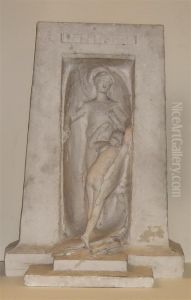Max Blondat Paintings
Max Blondat was a French sculptor whose work emerged at the turn of the 20th century, a period marked by significant transformations in the arts across Europe. Born in 1872 in Joigny, France, Blondat was part of a generation of artists who sought to explore and express new ideas, breaking away from the strictures of academic art to explore the possibilities of form, material, and expression in sculpture. Throughout his relatively short life—he died in 1925 at the age of 53—Blondat developed a body of work that demonstrated both technical mastery and a willingness to experiment.
Blondat's training began at the École des Beaux-Arts in Paris, where he was a pupil of the renowned sculptors Jules-Félix Coutan and Louis-Ernest Barrias. This period of study grounded him in the traditions of French sculpture, which he would both adhere to and diverge from throughout his career. Early on, he exhibited at the Salon des Artistes Français, a prestigious venue for artists to showcase their work, and he quickly gained recognition for his skill and innovative approach to sculpture.
His work often reflected the Art Nouveau movement's influence, characterized by organic forms, curvilinear designs, and a focus on nature. However, Blondat was not confined to a single style; his oeuvre includes a range of subjects from allegorical figures to more personal, introspective pieces. Notably, he also engaged with public commissions, contributing to the sculptural landscape of public spaces in France.
One of Blondat's significant contributions was his ability to convey emotion and humanity through bronze and stone. His sculptures are marked by a dynamic sense of movement and a delicate handling of details, which invite viewers to engage with the works on a deeply personal level. Despite the acclaim he received during his lifetime, Blondat's legacy has been somewhat overshadowed by his contemporaries. Nevertheless, his work remains an important part of the narrative of French sculpture in the early 20th century, offering insights into the period's artistic shifts and the search for new modes of expression.
Max Blondat's death in 1925 marked the end of a career that was both productive and innovative. Although he is not as widely recognized today as some of his peers, his contributions to the field of sculpture continue to be appreciated by art historians and collectors. His works are included in the collections of several museums and public spaces, serving as a testament to his artistic vision and skill.
